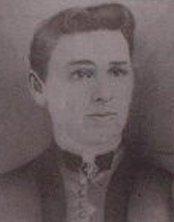
 The Women's Legacy Project of Snohomish
County, Washington seeks to honor our foremothers by recording and
sharing their personal histories, their ability to adapt to the forces
of change and their constant vigilance as stewards of the
diverse cultures of our society. The Women's Legacy Project of Snohomish
County, Washington seeks to honor our foremothers by recording and
sharing their personal histories, their ability to adapt to the forces
of change and their constant vigilance as stewards of the
diverse cultures of our society.
www.snohomishwomenslegacy.org |
|
|
 Amelia Austin ~
Tualco Valley Pioneer
1879 - 1908 Amelia Austin ~
Tualco Valley Pioneer
1879 - 1908By Nellie Robertson
Amelia Wellman Austin fought the battles of life
undaunted by the significant challenges she faced. From the
time of her birth in Joliet, Ill. in 1849 until her 1908
death in Monroe, the intrepid Amelia refused to concede
defeat. Her life encompassed the roles of pioneer wife,
mother, nurse, churchwoman, widow and community activist.
Her odyssey from Illinois to Tualco Valley south of Monroe
began while Amelia was still an infant. Her father had
crossed the American plains by ox team to discover
California riches, returned to get his family and with
several others headed again for the Pacific Coast, this time
choosing a route through the Isthmus of Panama. The men
slogged their way through the steamy jungle while the women
and children rode on the backs of native bearers. |
| Amelia met Grannis Austin in California, married him in
1865, and bore three children in the Golden State. Grannis
yearned to move on. The family booked passage on the Prince
Albert, an old blockade runner, and on June 10, 1873 at last
reached Snohomish County. The Austins took a pre-emption
claim on the land still occupied by their descendants. |
| The first white woman to travel the trail from Snohomish
to Tualco Valley made the journey just five months before
she gave birth to the first white child born in the valley.
She bore four more children in Washington Territory. In her
precise handwriting, she listed her children in the family
Bible. The first, Benjamin Grannis Austin, she wrote, was
born in "Calafornia" in 1866. Of her nine children, only
three sons and one daughter grew to maturity. Amelia met
challenges of motherhood, including the death of her
firstborn at the age of four, with the stoicism of a pioneer
woman. Three more died in childhood, and her last child died
when he was six months old. |
| Her children, who were happy to have Indian youngsters
as playmates in the sparsely-settled valley, inherited
Amelia’s bold nature. Once, when the elder Austins were on a
day-long trip to Snohomish, two of their sons took advantage
of parental absence to slake their hunger for brown sugar,
which was sold in large wooden boxes. Amelia had carefully
stowed the box under her bed specifically to keep it from
her rambunctious sons. Undeterred, the boys wrestled the box
out from its hiding place and gorged on the confection to
the point that by the time their parents returned, both boys
were thoroughly sick. Although a few swats were probably
applied to the boys’ backsides at some point, Amelia
lovingly applied her nursing skills to restore them to
health. |
|
Amelia nursed anyone who needed her.
Not only did she care for those who came to her for help,
but time and time again, traveled far and wide on foot or
horseback or by team and wagon to tend her fellow pioneers.
Tending the sick meant measuring medicinal doses, child
care, laundry and wood chopping. Her granddaughter, Doris
Reiner, said, “Being a Good Samaritan in those days was much
harder than staying home and doing your own thing in your
own surroundings.”
Used to traveling over difficult
terrain, audacious Amelia added another “first” to her list.
She was the first woman to take a pleasure trip to Sultan,
an occurrence unheard of in 1891. She and a friend visiting
from Colorado rode mules for their miles-long journey.
|
| A highly respected woman in the Monroe community, Amelia
found outlets for her boundless energy in the Ladies of the
Maccabees and the Rebekah Lodge. Her moral strength led her
to start a Sunday school in the Austin livery stable, and
after two years of hard work, the first Monroe church stood
on the present site of the Monroe United Methodist Church,
known then as the Methodist Episcopal (ME) Church. Not only
did Amelia provide a place for the church, but also for the
post office that had been moved from the neighboring
Smallman place to the Austin homestead. A boat delivered the
mail to the Snoqualmie River landing, and then a rider
carried it on horseback for the final few miles. |
Grannis Austin’s obituary in 1906 said that his wife had
helped him turn a wilderness into a ranch valued at $20,000.
Amelia spent little time in her widow’s weeds feeling sorry
for herself. In mid-summer that same year, she erected a
two-story building on Monroe’s So. Lewis Street that still
stands. With its lodge room upstairs and a couple of
business spaces downstairs, it became a popular site for
community meetings. When schools overflowed with students,
classes met there, and at one time the Austin building
housed a skating rink.
Her business acumen was legendary among men and women alike.
Her estate had doubled in value since her husband’s death.
Amelia Austin lost her battle with breast cancer in 1908.
She left behind a moral fiber that remains enshrined in the
church she helped start. Her community spirit blazed a path
women are still following today. |
|
Sources. Monroe Monitor
newsclippings & Austin family documents and Austin family
interviews
© 2002 Nellie Robertson All
Rights Reserved |
| |

 Amelia Austin ~
Tualco Valley Pioneer
1879 - 1908
Amelia Austin ~
Tualco Valley Pioneer
1879 - 1908